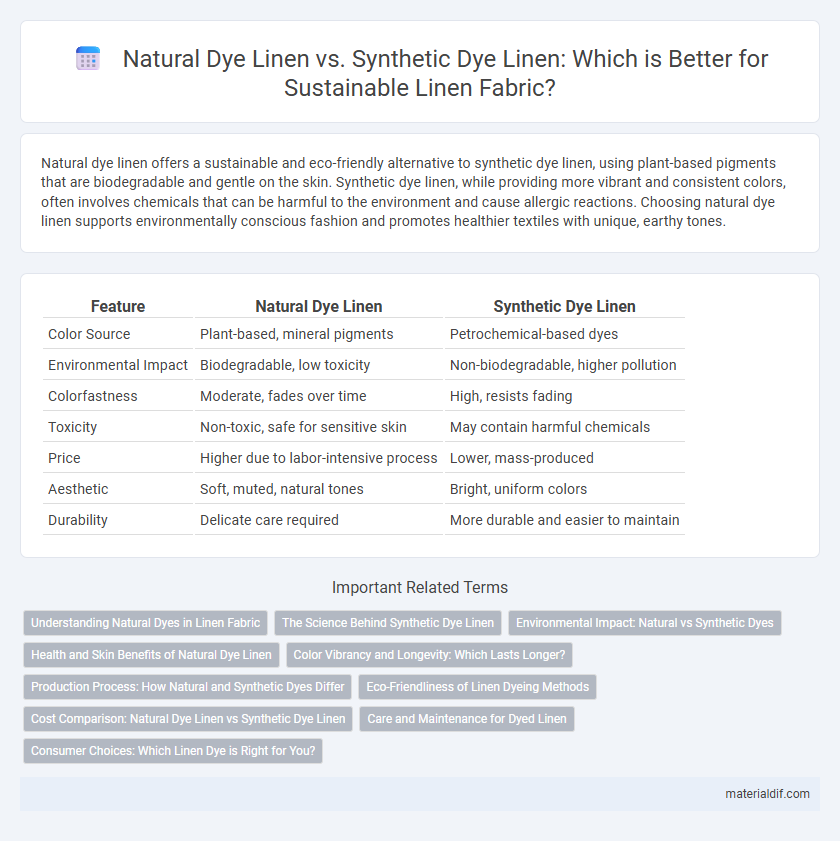Natural dye linen offers a sustainable and eco-friendly alternative to synthetic dye linen, using plant-based pigments that are biodegradable and gentle on the skin. Synthetic dye linen, while providing more vibrant and consistent colors, often involves chemicals that can be harmful to the environment and cause allergic reactions. Choosing natural dye linen supports environmentally conscious fashion and promotes healthier textiles with unique, earthy tones.
Table of Comparison
| Feature | Natural Dye Linen | Synthetic Dye Linen |
|---|---|---|
| Color Source | Plant-based, mineral pigments | Petrochemical-based dyes |
| Environmental Impact | Biodegradable, low toxicity | Non-biodegradable, higher pollution |
| Colorfastness | Moderate, fades over time | High, resists fading |
| Toxicity | Non-toxic, safe for sensitive skin | May contain harmful chemicals |
| Price | Higher due to labor-intensive process | Lower, mass-produced |
| Aesthetic | Soft, muted, natural tones | Bright, uniform colors |
| Durability | Delicate care required | More durable and easier to maintain |
Understanding Natural Dyes in Linen Fabric
Natural dye linen offers eco-friendly benefits by using plant-based pigments such as indigo, madder root, and turmeric, which provide rich, biodegradable color that ages gracefully without harmful chemicals. The fiber's porous structure absorbs natural dyes deeply, enhancing colorfastness and breathability while maintaining linen's inherent moisture-wicking properties. Understanding the interaction between flax fibers and natural dyes helps optimize dyeing techniques, ensuring sustainable, vibrant textiles with reduced environmental impact compared to synthetic alternatives.
The Science Behind Synthetic Dye Linen
Synthetic dye linen is created using chemical compounds designed to bond with cellulose fibers in linen, providing vibrant and long-lasting color through a process called azo dyeing. This method involves complex reactions that produce stable chromophores, ensuring resistance to fading from light and washing. The precision of synthetic dyes allows for consistent color replication and enhanced fabric durability, distinguishing it from the variability found in natural dye linen.
Environmental Impact: Natural vs Synthetic Dyes
Natural dye linen significantly reduces environmental harm due to its use of biodegradable pigments derived from plants, minimizing water pollution and chemical waste. Synthetic dye linen often involves petrochemical-based compounds that contribute to toxic effluents and higher carbon emissions during production. Choosing natural dyes supports sustainable textile practices by lowering ecological footprints and preserving water quality in dyeing processes.
Health and Skin Benefits of Natural Dye Linen
Natural dye linen offers superior health and skin benefits compared to synthetic dye linen, as it is free from harmful chemicals and toxins commonly found in synthetic dyes. The natural pigments reduce the risk of skin irritations, allergies, and contact dermatitis, making it ideal for sensitive skin and eco-conscious consumers. Moreover, natural dye linen often maintains better breathability and moisture-wicking properties, enhancing overall comfort and skin health during wear.
Color Vibrancy and Longevity: Which Lasts Longer?
Natural dye linen offers a unique, subtle vibrancy that deepens over time, creating a rich, organic aesthetic. Synthetic dye linen provides brighter, more consistent colors initially, but these can fade faster with exposure to sunlight and frequent washing. Overall, natural dyes tend to age gracefully with enhanced longevity, while synthetic dyes prioritize immediate brilliance but often sacrifice long-term durability.
Production Process: How Natural and Synthetic Dyes Differ
Natural dye linen involves extracting colors from plant-based sources, insects, or minerals through traditional methods that emphasize sustainability and reduce chemical waste. Synthetic dye linen uses chemically formulated dyes created through industrial processes, resulting in more consistent and vibrant colors but with higher environmental impact due to toxic chemical runoff. The natural dyeing process is labor-intensive and slower, while synthetic dyeing offers faster production and enhanced colorfastness.
Eco-Friendliness of Linen Dyeing Methods
Natural dye linen utilizes plant-based pigments derived from sources like indigo, madder, and turmeric, offering biodegradable and renewable coloring options that minimize environmental pollution. Synthetic dye linen often relies on petrochemical-based compounds that can release harmful effluents and heavy metals into water systems, posing significant ecological risks. Eco-friendly linen dyeing methods favor natural dyes combined with low-impact mordants and water-saving techniques to reduce chemical waste and carbon footprint during fabric production.
Cost Comparison: Natural Dye Linen vs Synthetic Dye Linen
Natural dye linen typically incurs higher production costs due to the labor-intensive extraction process and limited availability of organic pigments. Synthetic dye linen offers a more cost-effective option with consistent colorfastness and mass-production efficiency. Despite the initial expense, natural dye linen appeals to eco-conscious consumers seeking sustainable and chemical-free textiles.
Care and Maintenance for Dyed Linen
Natural dye linen requires gentle care to preserve its organic pigments, often benefitting from hand washing with mild detergents and avoidance of harsh chemicals or prolonged sun exposure that can fade colors. Synthetic dye linen is typically more colorfast and can tolerate machine washing at moderate temperatures, but still needs to be protected from bleaching agents to maintain vibrancy. Both types of dyed linen should be air-dried away from direct sunlight to prevent degradation of fibers and color loss.
Consumer Choices: Which Linen Dye is Right for You?
Natural dye linen offers eco-friendly benefits with biodegradable pigments derived from plants, appealing to environmentally conscious consumers seeking sustainable fashion choices. Synthetic dye linen provides vibrant, long-lasting colors with greater variety, catering to those prioritizing durability and colorfastness in their textiles. Choosing the right linen dye depends on individual preferences for sustainability, color intensity, and fabric care requirements.
Natural Dye Linen vs Synthetic Dye Linen Infographic

 materialdif.com
materialdif.com